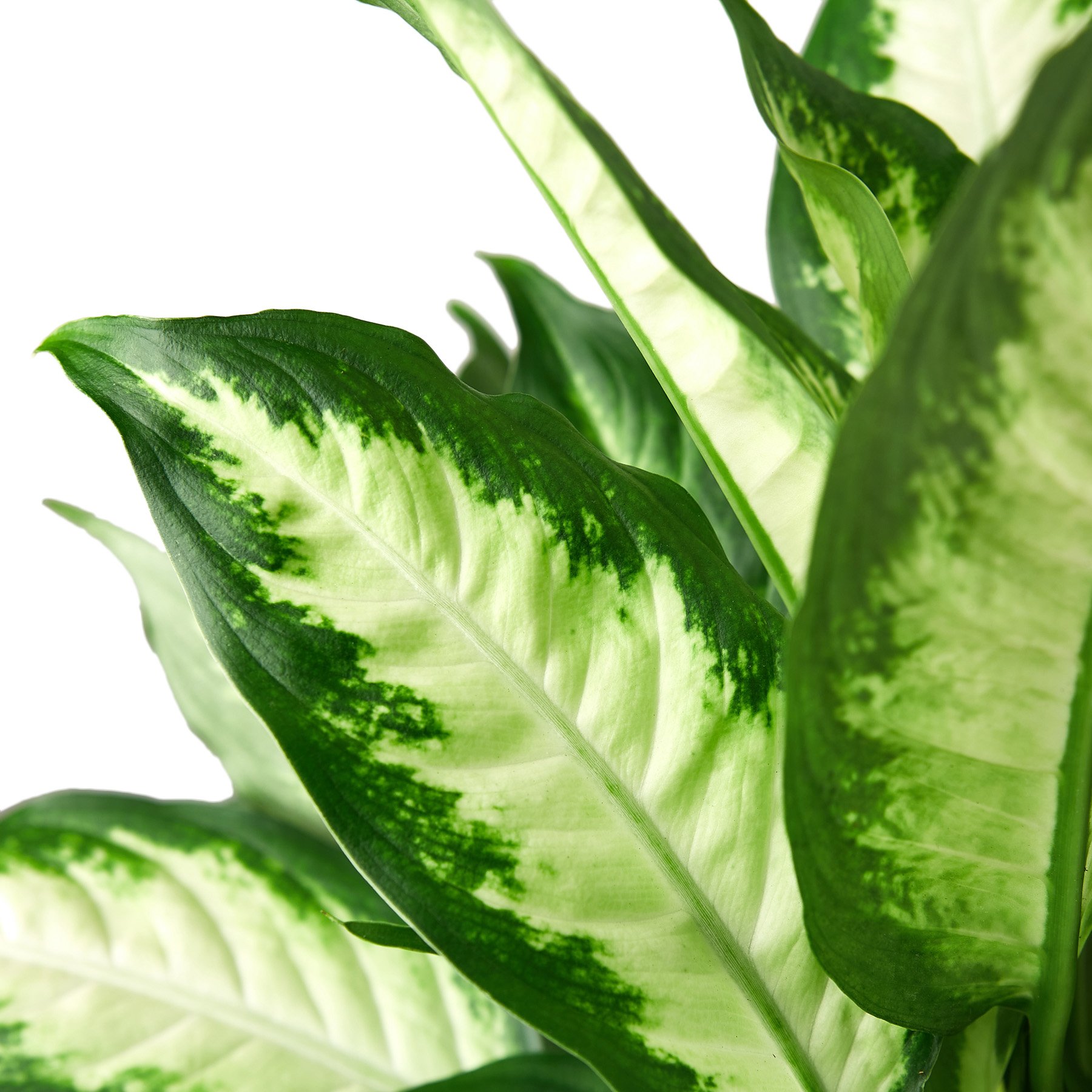Plant Spotlight of the Week: Dieffenbachia
Dieffenbachia, better known as dumb cane, are tropical plants that hail from Mexico and the West Indies. With leaves great for purifying the air this plant is highly adaptable and fit for any space in your home. We’re shining our spotlight this week on the dieffenbachia. Let’s jump in!
Light: Dieffenbachia prefers bright, indirect light. Too much direct sunlight can scorch the leaves, while too little light will cause the leaves to become pale and leggy. Dieffenbachia prefers bright, indirect light. Too much direct sunlight can scorch the leaves, while too little light will cause the leaves to become pale and leggy. The ideal location for a dieffenbachia is in a spot that receives bright, indirect light for most of the day. A south-facing window is ideal, as this will provide the plant with plenty of light without the risk of scorching. If you do not have a south-facing window, you can also place your dieffenbachia in an east- or west-facing window. Just be sure to rotate the plant regularly so that all sides receive an equal amount of light. If you are not sure whether your dieffenbachia is getting enough light, you can check the leaves. If the leaves are a healthy green color and are not wilting or curling, then the plant is getting enough light. If the leaves are pale or yellow, then the plant is not getting enough light. You can also try to see if the leaves are pointing towards the light source. If they are, then the plant is getting enough light. If they are not, then you may need to move the plant to a brighter location.
It is important to note that dieffenbachias can tolerate some shade, but they will not thrive in low-light conditions. If you are only able to provide your dieffenbachia with low light, you will need to water it less frequently and be more careful not to over fertilize it.
Water: Dieffenbachia should be watered regularly, but not too often. Allow the top 5-7 cm of soil to dry out before watering again. Overwatering can cause root rot, which can kill the plant.
The best way to determine when to water your Dieffenbachia is to stick your finger into the soil. If the top 5-7 cm of soil is dry, it's time to water. If the soil is still moist, wait a few more days before watering again.
It's important not to overwater Dieffenbachia, as this can lead to root rot. Root rot is a fungal infection that can kill the plant. Symptoms of root rot include yellowing leaves, wilting, and stunted growth. If you think your Dieffenbachia may have root rot, you should repot it in fresh soil and water it less frequently. You can also help prevent root rot by using a pot with drainage holes. This will allow excess water to drain away from the roots, preventing them from becoming waterlogged.
Humidity: Dieffenbachia prefers high humidity. If the air in your home is dry, you can mist the leaves regularly or place the plant on a pebble tray filled with water. When misting, be sure to use room temperature water and avoid getting the leaves wet at night, as this can increase the risk of fungal growth. If you choose to use a pebble tray, make sure the water level is not too high, as this can also lead to root rot.
Temperature: Dieffenbachia is a tropical plant and prefers warm temperatures. The ideal temperature range is between 65-80 degrees Fahrenheit. It can tolerate temperatures as low as 55 degrees Fahrenheit, but prolonged exposure to cold temperatures can cause the leaves to turn yellow and drop. Dieffenbachia is also sensitive to sudden changes in temperature, so it is important to gradually acclimate the plant to new conditions.
If you live in a hot climate, you may need to take steps to protect your Dieffenbachia from the heat. Direct sunlight can scorch the leaves, so it is best to place the plant in a spot where it will receive indirect sunlight. You can also mist the leaves regularly to help keep them cool and hydrated.
Fertilizer: Dieffenbachia should be fertilized once a month during the growing season (spring and summer). Use a balanced fertilizer, such as a 20-20-20 fertilizer. Dilute the fertilizer to half strength and apply it to the soil around the plant. Do not fertilize the plant during the winter months, as this can cause the plant to go dormant.
If the leaves of the plant are yellowing or wilting, this may be a sign that the plant is not getting enough nutrients. Try fertilizing the plant more often or using a fertilizer with a higher nitrogen content. Be careful not to over-fertilize the plant, as this can also damage the plant. If you are unsure about how much fertilizer to use, it is always better to err on the side of caution and use less fertilizer than more.
Dieffenbachia is susceptible to a variety of pests, including:
Aphids: These small, soft-bodied insects feed on the sap of plants, causing leaves to yellow and wilt. They can also transmit diseases. To control aphids, spray the plant with a water-and-soap solution or an insecticidal soap.
Mealybugs: These small, white insects also feed on the sap of plants, causing leaves to become distorted and discolored. They can also produce a sticky substance called honeydew, which can attract ants. To control mealybugs, wipe them off the plant with a cotton swab dipped in rubbing alcohol or insecticidal soap.
Spider mites: These tiny, eight-legged arachnids feed on the sap of plants, causing leaves to become stippled and yellow. They can also produce a fine web that covers the leaves. To control spider mites, spray the plant with a water-and-soap solution or an insecticidal soap.
If you notice any pests on your plant, it is important to treat them promptly to prevent them from spreading and damaging the plant.
Propagation:
Dieffenbachia can be propagated by stem cuttings, division, and air layering. To take a stem cutting, take a 6-8 inch cutting from the stem and remove the bottom leaves. Dip the cutting in rooting hormone and place it in a pot of moist potting soil. Keep the soil moist and the cutting will root in about 4-6 weeks.
Stem cuttings:
To propagate Dieffenbachia by stem cuttings, take a 6-8 inch cutting from the stem. Remove the bottom leaves, and dip the cutting in rooting hormone. Place the cutting in a pot of moist potting soil, and keep the soil moist. The cutting will root in about 4-6 weeks.
Division:
To propagate Dieffenbachia by division, carefully remove the plant from its pot. Gently tease the roots apart, and divide the plant into two or more sections. Replant each section in its own pot, and water well.
Air layering:
To propagate Dieffenbachia by air layering, make a cut in the stem about 2 inches below a node. Cover the cut with moist sphagnum moss, and secure the moss in place with a rubber band. Keep the moss moist, and the cutting will develop roots in about 4-6 weeks. Once the roots have developed, you can cut the stem below the node and transplant the new plant.
Troubleshooting: If your dieffenbachia is not doing well, there are a few things you can check for:
Overwatering: If the leaves are yellow or brown and the soil is constantly wet, the plant is being overwatered. Reduce the frequency of watering and allow the soil to dry out more between waterings.
Underwatering: If the leaves are wilted and the soil is dry, the plant is being underwatered. Water the plant more frequently and make sure the soil is moist but not soggy.





